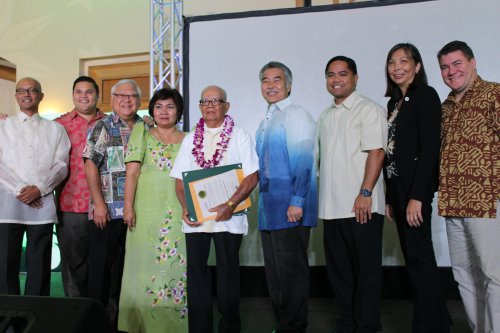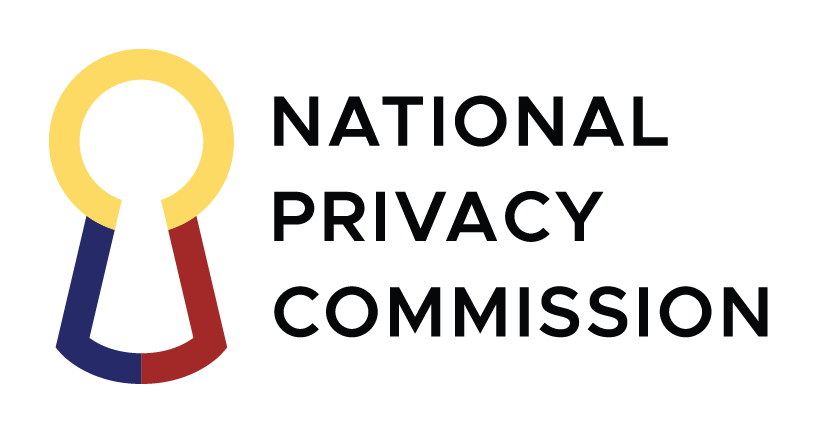
Mr. Avelino Raymondo (center) was one of the 4 living sakadas who were honored at the event. Joining him onstage were (L-R): Senator Wil Espero; Representative Ty Cullen; Senator Clarence Nishihara; Consul General Jamoralin; Governor Ige; Representative Henry Aquino; Representative Joy San Buenaventura and Representative Matthew LoPresti.
Four (4) living sakadas, who were in their late 80s to 90s, were honored, and recognition was given to the other living sakadas who had been previously honored during the inaugural Sakada Day celebration on 20 December 2015. The celebration was also held in commemoration of the 110th year since the arrival of the first 15 sakadas to Hawaii.
This year’s celebration also paid tribute to the Filipino migration that was started by the sakadas who came to Hawaii to work in medical, hospitality, tourism, construction, and other service professions, as well as the Filipino veterans of World War II who came to live in Hawaii with their families, following them, who also form part of the Filipino community in Hawaii.
Attendees of the 2nd Sakada Day celebration include US and Philippine government officials, Hawaii legislators, military officials, members of the Consular Corps of Hawaii, the Filipino community, the living sakadas and their descendants. Governor and Mrs. David Ige as well as Admiral Harry B. Harris, Commander of the US Pacific Command, were the Guests of Honor.
In her remarks, Philippine Consul General Jamoralin expounded the significance of the event and encouraged those present to continue telling the story of the sakadas. “Let us continue to tell the story of the Sakadas to our children, grandchildren, great- grandchildren: to the Baby Boomer generation, Generation X, Generation Y, the Millennials and the generations after us. From the first fifteen Sakadas who arrived in 1906, to the final 6,000 who arrived in 1946, or the Sakada ’46 as they were called, their story is an inspiring tale of fortitude and hope for our future,” she said.
Governor Ige remarked about Hawaii being one of the world’s largest exporters of pineapple and sugar with Filipinos making up the backbone of its work force. He also shared about the last harvest of the last sugar plantation in Hawaii, the Hawaiian Commercial and Sugar Plantation (HC&S) in Hawaii on 12 December 2016 in Maui where he was reminded of the legacy of the Filipino sakadas.
To honor the 4 living sakadas, certificates were given to each sakada by the Philippine Consulate General, the Government of the State of Hawaii, the Office of Honolulu Mayor Kirk Caldwell and the Hawaii State Legislature.
US Senators Brian Schatz and Mazie Hirono, Mayor Caldwell, Deputy Speaker of the Philippine House of Representatives Eric Singson and Ilocos Sur Governor Ryan Singson also sent their messages for the occasion.
A special production number highlighting the stories of the early Sakada, from departure in Port Salomague in the Philippines to their arrival in Hawaii, their experiences in the sugar plantations and their aspirations for the future generations, followed the program.
House Bill 604, “Relating to Sakada Day” was signed on 9 April 2015 by Hawaii Governor David Ige. The said bill, which designates December 20 of every year as “Sakada Day”, recognizes and honors the pioneering achievements and courage of the first Filipino sakadas and their contributions to the history and development of Hawaii.
The Sakada Day celebration was made possible through the collaborative efforts of the Philippine Consulate General in Honolulu and the major Filipino community organizations including the Oahu Filipino Community Council (OFCC), Congress of Visayan Organizations (COVO), Philippine Celebrations Coordinating Committee of Hawaii (PCCCH), United Filipino Council of Hawaii (UFCH), the Filipino Community Center, the Filipino Chamber of Commerce of Hawaii (FCCH) and the Knights of Rizal (KOR) Hawaii Chapter, the Filipino Community Center and other sponsors. (END).

